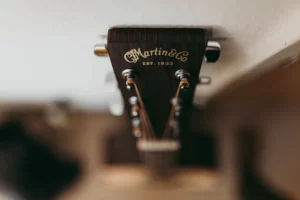The Fender Stratocaster is now the most immediately identified guitar in the industry without uncertainty. This is the best choice for beginning guitarists. Would you like to add another Stratocaster to your collection? Then this Squier Standard Stratocaster review will assist you in adding this product to your guitars collection. Is it the first electric guitar to be combined with a decent-sized amplifier to practice on as a newbie? This is maybe the single guitar that can be observed in almost all musical genres.
The Squier Standard Stratocaster is slightly more pricey than the Strat, but for a worthwhile purpose. It features a more extensive selection of matt and glossy dye types for guitarists from which to choose. The high-level pickups the guitar is outfitted with are unquestionably lighter and superior at giving the desired performance on a Stratocaster instrument.
My Squier Standard Stratocaster Review
Construction
The first element I chose to look into is the parts that would make a Squier Standard Strat nowadays, and the core of its tone, as with any guitar, is the timber utilized. The body of this guitar is composed of agathis wood. Don’t feel guilty if you have to search it: complete transparency. I tried as well! It’s a less affordable choice than hardwood, and it’s much more abundant in the east, where all these guitars are manufactured.
That may raise some eyebrows, but keep in mind that this would be a cheap guitar, and you won’t have the same premium sound materials as one that costs $1,500. Nevertheless, Squier is a Stratocaster sub-brand, but they’re not trying to ruin the brand legacy with bad-sounding wood. It’s a fine line to tread. The preponderance of the products linked to that agathis is unbranded. This represents the guitar’s price range, even though a manufacturer like Stratocaster would have some sort of consistency regulation in place.
Remodeling
It is indeed essential getting a decent glimpse into how the instrument was appropriately soldered right out of the box. As I inspect a fender strat such as this one, I start with the neck part. Whether there are clear indicators of substandard design, they will most possibly be present.
However, I was delighted with how clean that is: the neck seemed to be level with the body; there were no breaches; it never seemed to have been pressed in (which sounds crazy, like I’ve said! ); and there were no unattractive glue scars. Anyway, thus far, so wonderful. Looking down the neck, everything appeared friendly and equal, and a careful examination discovered a very immaculate finish along with the fingers and bridge. Almost everything, including the device blades, basses, and controls, appeared to be completely fastened. Absolutely, I poked it with my fingertip and saw how they’re performing!
Tones
The much more fun aspect is discovering what sounds good! I learned that this is a matter of giving new electric guitars a couple starts singing as you acquire them. But you can perceive it as an instrument instead of a guitar and amplifier, if that feels right? Users might not want to immediately turn everything up so high that everything you can hear is distorted riffs and screeches! The bottom E became clanky upon that sixth note, nothing a little touch tuning couldn’t remedy. I was unconcerned.
My amplifier is a 15-watt all-valve combination produced in China by a British company. That’s a great amp that has never disappointed me wrong, but there has not been a guitar I’ve played through it, and it hasn’t sounded fantastic. With the Stratocaster connected, I went immediately to my default parameters: bass at four, midrange and treble at six, gain at six, and volume at a neighbor-friendly six.
Quality
I anticipated soul music in the spirit of Rory Gallagher and Eric Clapton out of this Stratocaster. I started with the bridge collection and, to be honest, I can’t appreciate it. I’m not a lover of neck pickers in general. However, this could do nothing to reconsider my position. Albeit with my remarkable lever amplifier, I considered it too abrasive. I can’t spend time just on bridge/middle pairing; however, the short reason I invested there suggested that I’m on the proper path. I figured I’d struck the perfect balance as I arrived at the intermediate grab. It played big enough according to harmonics, yet the excursions still will pierce through into the remainder of the racket in a musical setting. This would be an excellent all-around location.
The moderate and neck pick levels are sometimes too murky for me. I might envision someone playing in a distinctive style – perhaps someone a bit grungier – gel-forming with that, but it wasn’t for me. Although I thought I’d discovered something that would do the job, it couldn’t match with a much more pricey design from Fender’s lineup.
Playability
Throwing the acoustics aside, I’d like to evaluate the playability of this instrument. An instrument can sound as well as you ever need it all to, but you won’t return to it if that doesn’t feel comfortable playing. As a result, it is a waste of resources. I’m hardly trying to assert that this is the best instrument you’ll ever play, but it is perfectly reasonable. It will do the trick, but the project’s scope, I can’t promise that I’ll don’t ever sell it.
The play is a tad too fast out of the packaging for my taste. It’s nothing that a setup couldn’t cure. Still, considering the expense of obtaining guitars correctly configured on such days and the worth of this instrument, I’d instead try everything myself rather than part with my money.
Design
Skimming up and down, the fretboard has no tightness or grip, which is precisely what you desire, considering its unfettered origin. The neck does have a C-shaped design that I felt was comforting, but because every player’s hands are varied, this is subjective. I’m never trying to mention that the neck would suit everyone! Squiers have very tough, delicate balancing acts on their palms. Manufacturers must produce excellent devices in a fiercely competitive environment at reasonable prices.
Two players would benefit from their standard Strat—novices who desire to mimic their favorite Strat-players; and professionals who occasionally require it for anything. That’s an attractive choice for those looking to learn more about electric guitars and gain a sense of the guitar. Professional musicians may make some suggestions or recordings, but no one will win a Grammy with a Squier Strat or use it as their primary instrument. Me? I’ll hold onto it for a while. But I’m not currently selling any of my other guitars to create an opening that would have a suitable home. Because we’re such a picky lot, I’d wholeheartedly suggest lending one from a colleague or going to a shop to purchase one before you acquire one.

Specification
- Series: Standard Series
- Color: Cherry Sunburst (Polyurethane Finish)
- Body: Agathis
- Neck: Maple, S/C -Shape (Polyurethane Finish)
- Fingerboard: Rosewood, 9.5″ Radius
- No. of Frets: 22 Medium Jumbo
- Pickups: 3 Alnico Magnet Single-Coil Pickups
- Controls: Master Volume, Tone 1. (Neck Pickup), Tone 2. (Middle Pickup)
- Pickup Switching: 5-Position Blade
- Bridge: Synchronous Twin-Pivot Tremolo
- Machine Heads: Standard Die-Cast Tuners
- Hardware: Chrome
- Pickguard: 3-ply parchment
- Scale Length: 25.5″
- Width at Nut: 1.650″
- Large ’60s Style Headstock
- Gold and Black Squier Logo
- Engraved Neck Plate
- White Plastic Parts
- Dot Position Inlays
How do Squier standard Stratocasters compare to other types of electric guitars?
The Standard Stratocaster is an appealing and affordable classic with an excellent blend of technological appearance and modern functionality. It is an excellent replacement for any guitarist looking to upgrade to a professional-quality instrument. Of course, it is outstanding compared to other types of electric guitars.
What makes the Squier standard guitar the best electric guitar under $500?
Since you only have $500 to invest in a musical instrument, you may believe that the most fantastic guitars are out of your price range. If you do have the budget, choose the Standard over the Squire because the Squire is genuinely a novice guitar. The Standard comprises three single-coil pickups, a coordinated tremolo with a high-mass bridge square, and a fingerboard symbol in the manner of the 1970s. Although some companies sell this instrument for close to $400, it is more often found for less than $500.
What are different Electric guitar body styles? Which one is the style of Squier Standard Stratocaster?
The main electric guitar bodies can be divided into three:
- Hollow Body Instruments
- Semi-Hollow Body
- Solid-Body Instruments
Squier Standard Stratocaster comes in a type of Solid Body Electric Guitars. The Stratocaster is among the most famous guitars in history but not the most popular. The word “electric guitar” is nearly associated with the unconventional double-cutaway form. Several businesses and guitar makers have imitated and duplicated the form and tone of the Strat. The Strat, which debuted in 1954 as a follow-up to the Stratocaster, was supposed to be much more significant than its predecessor.
Each algorithm has three cutaways, circular corners, three pickups with a 5-way throttle valve, and a whammy lever. These specifications were unheard of on a commercial guitar. Notwithstanding its success, the basic model underwent minimal improvements, except for the American Standard Stratocaster, which featured a slightly larger and shallower neck and an enhanced Arpeggiated System. The underlying model has stayed mostly unchanged. The tone of the Strat is bright but not as plucked as that of the Telecaster. With three pickups, you should be able to get the right sound for your requirements. It complements blues, rock, funk, metal, and anything else.
Final Verdict
Finally, the Standard Stratocaster is a good buy for beginners and medium-level players, while expert guitarists can’t see anything wrong with a decent Strat upgrade. It performs well, and with a few minor design changes, it seems like a massive upgrade from Squier’s considerably cheaper Strats. I hope this Squier standard Stratocaster review guide will help you decide to choose a guitar of your own style. If you are looking for something that will last for years, this is definitely the best electric guitar for sale!







